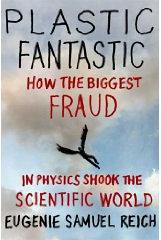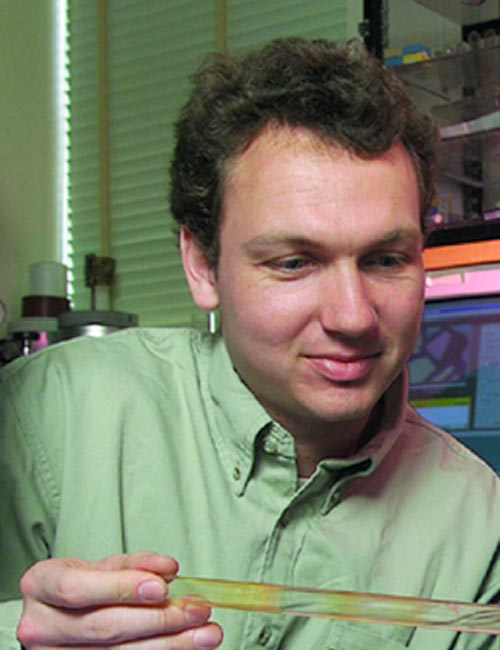tags: book review, Plastic Fantastic, How the Biggest Fraud in Physics Shook the Scientific World, physics, ethics, fraud, Bell Labs, Lucent Technologies, Jan Hendrik Schön, Eugenie Samuel Reich
 Physicist Jan Hendrik Schön was too good to be true. After graduating from the University of Konstanz in 1997, he was hired by Bell Labs in New Jersey, where he quickly rose to scientific fame. By 2000, he had published eight papers in the world's most prestigious journals, Nature and Science. One year later at the height of his career, he was publishing one scientific paper every eight days -- remarkable productivity. But suddenly, by May 2002, Schön's meteoric rise collapsed into a smoking ruin. His work was discovered to be nothing more than fabrications that required no experimentation, mere creations that sprang to life in response to his colleagues' excited speculations about the next great discovery that awaited physicists. How was Schön able to fool the best and the brightest scientists in the world for five years? Why did he fake his data? These are the questions that author Eugenie Samuel Reich explores in her book, Plastic Fantastic: How the Biggest Fraud in Physics Shook the Scientific World (NYC: Palgrave Macmillan; 2009).
Physicist Jan Hendrik Schön was too good to be true. After graduating from the University of Konstanz in 1997, he was hired by Bell Labs in New Jersey, where he quickly rose to scientific fame. By 2000, he had published eight papers in the world's most prestigious journals, Nature and Science. One year later at the height of his career, he was publishing one scientific paper every eight days -- remarkable productivity. But suddenly, by May 2002, Schön's meteoric rise collapsed into a smoking ruin. His work was discovered to be nothing more than fabrications that required no experimentation, mere creations that sprang to life in response to his colleagues' excited speculations about the next great discovery that awaited physicists. How was Schön able to fool the best and the brightest scientists in the world for five years? Why did he fake his data? These are the questions that author Eugenie Samuel Reich explores in her book, Plastic Fantastic: How the Biggest Fraud in Physics Shook the Scientific World (NYC: Palgrave Macmillan; 2009).
This is the story of a physicist who faked his discovery of a new type of superconductor made from plastic, a discovery that the media referred to as "Plastic Fantastic." As if that wasn't enough, he went on to claim he had achieved other amazing research results using plastic, such as producing lasers and observing strange quantum-mechanical effects. If his discoveries had been real, they would have heralded a huge advance in computer chip technology and there were even whispers that Schön could soon be awarded the Nobel Prize.
But as Schön raced from amazing one discovery to the next like an excited child bouncing between Easter eggs, his colleagues were left scratching their heads in his wake, because it was impossible to reproduce his research methods and data. Perhaps he developed into an exceptionally gifted experimentalist, they speculated. He certainly made everything look easy since he seemed to produce research data without any visible effort. But when his colleagues asked to watch him work in the lab, he modestly deferred, saying he did most of his work at his grad student lab alone in Germany using an old (and rather ordinary, as it turned out) piece of equipment. Schön's agreeableness, mild manners and vague answers made it difficult to challenge him since he quietly produced exactly what his supervisors and colleagues expected to see.
But not everyone was impressed with Schön. Sure, he was good -- making breakthrough contributions in several related fields -- but maybe he was a little too good. He was productive -- publishing tremendous numbers of papers -- but at least a few of his colleagues thought he was too productive.
Finally, late one night, while working on a patent for Bell Laboratories, one of Schön's bleary-eyed colleagues was looking at a stack of research papers and noticed something something extraordinarily peculiar: the data figures for two separate papers by Schön - one published in Nature and the other published in Science -- were identical, even down to the "noise" -- the background imperfections created by the measuring instruments themselves. After that observation, everything unraveled rapidly, and within one month, all of his scientific papers had been withdrawn. Further, even though he had not committed fraud as a graduate student, his university revoked his doctorate one year later.
This scientific detective story reads like a murder mystery -- fast-paced, suspenseful, and detailed -- except it is a true story. The author details how Schön actually did it, and even proposes reasons for how he managed to slip his fabricated data past so many high-caliber scientists for so long. But unfortunately, the author was unable to satisfactorily answer one of her main questions; why did he do it? Schön wasn't an egomaniac, nor was he an overt attention-whore. The price he paid hardly seems worth it. And after his fraud was discovered, Schön lost everything; his career and professional relationships, his job, funding, and even his diploma. I don't see how he benefitted (even in his own tiny world-view), nor does the author enlighten us.
All that said, I have a few complaints. The production value of this book was shockingly bad. First, there were no photographs in the book. Not one picture of Schön's university in Germany, nor of the research laboratories at Bell Labs, of his graduate adviser, his colleagues or supervisors. By the time I finished this book, I was so consumed with curiosity about all the people in this book that I dug up a picture of Schön on the internet, which I include in this review so you can see what he looked like while employed at Bell Labs.
I was also annoyed that there were no diagrams of the actual devices used -- the real ones, I mean. Like the equipment for sputtering, which comprised a large part of what Schön did for his dissertation work. Astonishingly, even though the initial damaging evidence against Schön was the result of the shocking sameness of his data, only one data figure was published in the entire book (on page 37). This image shows the two data images side-by-side, each from different papers, that tipped off his fellow physicists, Julia Hsu and Lynn Loo, to his duplicity. Unfortunately, this important image is so small it is difficult to study carefully without a magnifying lens.
Second, I was astonished and annoyed by the tremendous number of typographical errors throughout the book -- most of the cut-and-paste variety, where words or entire phrases were missing. Since the book was so detailed, these missing phrases really did serve to annoy and confuse the reader. I can only imagine the frustration a non-scientist might feel as a result. Did this book have an editor at all? If so, what was he drinking while editing?
Since I am being cranky in this review, I might as well be nit-picky, too. I was surprised at the poor quality paper that this book was printed on: thin, yellow, and very unpleasant to the touch, almost like newspaper. As a bibliophile, I can tell you that part of the joy of reading is the feel of the book in one's hands. Recycled toilet paper is better quality than this!
In short, I thought this book was fascinating, well-written and worth reading, but the publishers did an inexcusably amateurish job in editing and producing it. Self-published books have better production quality than this. Shame on you, Palgrave Macmillan!
Eugenie Samuel Reich is a former editor at New Scientist. She has written for Nature, New Scientist, and The Boston Globe, and is known for her investigative reports on irregular science and scientific fraud. Several of her reports have resulted in institutional investigations. She lives in Cambridge, Massachusetts. Plastic Fantastic is her first book.


Clearly a breakthrough in postmodern publishing.
High-quality verbiage, low-grade substance: the book's production values are a metacomment on its subject!
Thanks for bringing this volume to our attention... I'm surprised I've not heard of it before, nor even heard of the seemingly interesting case with which it deals. Recent decades have exposed a number of instances of fraud in biology and medicine, but cases in physics are rarer.
And sorry to hear of the poor production values, but maybe that has something to do with why I haven't run across the book during my bookstore rambles.
I read about that scientific fraud at the time here on ScienceBlogs, it would have deserved a better-written book.
Thanks for the review; such a pity the book weren't better.
I'm sad to say that in chemistry cut-and-paste publication seems to be the norm; I left chemistry because I was fed up with reading the same results 20 times with only a few words changed.
As a reviewer, when I speak to colleagues I discover that I'm one of the few who bother to look at diagrams in detail, check mathematical equations, and test the validity of claims or question the basis of claims (demand more data from the authors). I had recently reviewed a paper; a condition was that I had to submit my comments within 30 days (weekends included of course). It took me over 20 hours to go through, check references, comment on things, etc - that's half a working week (in my spare time) for a relatively short paper (18 pages). A lot of people just don't bother with the work, which is very unfortunate because that's when frauds and poor quality work get through. (I rejected the paper after all that work.)